Discover the perfect bread box plans PDF to create a functional and stylish storage solution for your kitchen. Easy-to-follow guides with detailed diagrams and step-by-step instructions ensure success for all skill levels, helping you craft a durable and attractive bread box to keep your bread fresh and your kitchen organized.
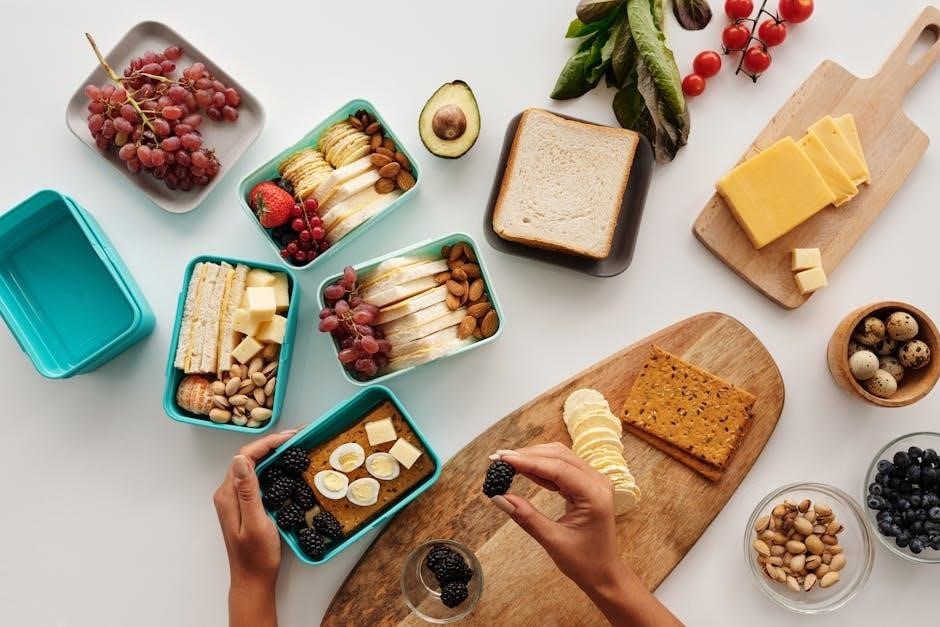
Overview of Bread Box Designs
Bread box designs offer a variety of styles and functionalities to suit any kitchen. From modern minimalist concepts to rustic, vintage-inspired models, these plans cater to diverse aesthetics. Many designs feature tambour doors or magnetic closures for easy access, while others incorporate adjustable shelves or pull-out cutting boards for added convenience. Space-saving compact designs are ideal for small kitchens, ensuring efficient storage without compromising on style. Materials range from durable woods like pine or cherry to versatile options like plywood or MDF. Each design emphasizes functionality, with features like ventilation to maintain bread freshness and ergonomic handles for easy opening. Whether you prefer a classic or contemporary look, these plans provide detailed guidance to craft a bread box that complements your kitchen decor while keeping your bread fresh and organized.
Importance of Using Bread Box Plans
Using bread box plans PDF ensures precision and efficiency in your woodworking project. These plans provide clear instructions, measurements, and diagrams, eliminating guesswork and saving time. They help beginners master essential techniques while allowing experienced crafters to refine their skills. With a plan, you can avoid costly mistakes and ensure your bread box is both functional and visually appealing. Plus, detailed material lists and step-by-step guides make it easier to stay organized and within budget. Whether you’re aiming for a modern or rustic design, bread box plans are indispensable for achieving professional-grade results and keeping your bread fresh in a beautifully crafted storage solution.
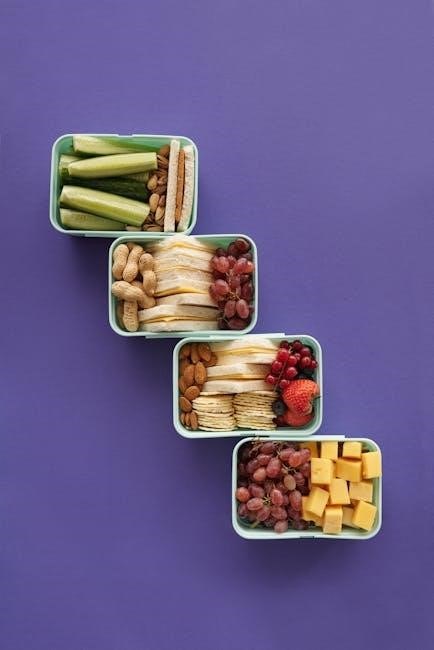
Materials and Tools Needed
To build a bread box, you’ll need materials like high-quality wood, hinges, and a durable finish. Essential tools include saws, sanders, drills, and measuring tools for precision.
Wood Selection for Bread Boxes
Choosing the right wood is crucial for durability and aesthetics. Popular options include maple, cherry, and oak for their strength and attractive grain patterns. Pine and cedar are also great choices, offering a lighter appearance and natural aromatic properties. For a more budget-friendly option, consider using plywood or MDF, which can be easily shaped and finished. Ensure the wood is properly sanded to avoid splinters and sealed for moisture resistance. When selecting wood, prioritize materials that are sturdy yet lightweight, making the bread box easy to move. Proper wood selection will enhance both functionality and the visual appeal of your bread box.
Essential Tools for Building a Bread Box
To construct a bread box, gather essential tools like a table saw or circular saw for cutting wood, a drill for pre-drilling holes, and sandpaper for smoothing surfaces. A jigsaw or bandsaw is handy for curved cuts, while clamps ensure precise alignment during assembly. Measuring tools, such as a tape measure and square, are vital for accuracy. Safety gear, including gloves and safety glasses, protects you during the process. Additional tools like a router for decorative edges or a sander for a polished finish can enhance the final product. Having these tools ready ensures a smooth and efficient building experience, allowing you to create a sturdy and attractive bread box with ease.
Additional Materials for Customization
Elevate your bread box with customization materials like plexiglass for visibility or magnetic closures for a sleek finish. Add decorative hardware, such as ornate hinges or handles, to enhance the design. Consider incorporating metal accents or glass panels for a modern touch. Paint or stain can match your kitchen aesthetic, while engraved details or decals add a personal flair. For functionality, include pull-out shelves or adjustable compartments. These materials allow you to tailor your bread box to your style and needs, ensuring it stands out as a unique, handcrafted piece in your home. Personalization options are endless, making your project truly one-of-a-kind.

Design Variations
Explore various bread box designs, from modern to rustic, including space-saving and two-story options, to suit every kitchen style and storage need.
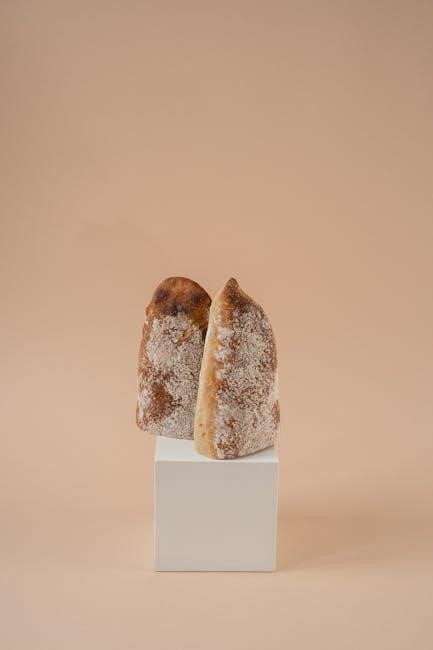
Modern Bread Box Designs
Modern bread box designs emphasize sleek lines, minimalist aesthetics, and functional features. Many plans incorporate materials like glass, metal, or engineered wood for a contemporary look. These designs often include features such as pull-out shelves, magnetic closures, or tambour doors for easy access. Some modern bread boxes also integrate technology, like LED lighting or ventilation systems, to enhance usability. Plans may vary in size, from compact countertops to larger wall-mounted units, ensuring versatility for any kitchen layout. With a focus on durability and style, modern bread box designs blend seamlessly into modern kitchens while maintaining the traditional purpose of keeping bread fresh.
Rustic and Vintage-Style Bread Boxes
Rustic and vintage-style bread boxes bring a charming, timeless appeal to your kitchen. These designs often feature distressed finishes, natural wood tones, and classic hardware like wrought iron or brass hinges. Many plans incorporate traditional craftsmanship, such as dovetail joints or hand-carved details, to create a nostalgic feel. The use of reclaimed wood or vintage-inspired materials adds authenticity to these designs. Rustic bread boxes typically have a sturdy, farmhouse-style appearance, with features like curved tops or ornate carvings. They not only preserve the freshness of your bread but also serve as a decorative centerpiece, blending seamlessly with traditional or country-themed kitchens. These plans cater to woodworking enthusiasts who appreciate classic aesthetics and functionality.
Space-Saving Compact Designs
Space-saving compact bread box designs are ideal for small kitchens, apartments, or countertops with limited space. These plans focus on maximizing storage efficiency while maintaining functionality. Often featuring vertical layouts or slim profiles, these bread boxes can fit neatly into tight spaces. Some designs include foldable or collapsible elements, while others utilize wall-mounted options to save counter space. Compact bread boxes may also incorporate multi-functional features, such as built-in cutting boards or adjustable shelves, to enhance utility. Despite their smaller size, these designs ensure your bread stays fresh and are perfect for those seeking practical, minimalist solutions for modern living. These plans are great for DIY enthusiasts looking to optimize their kitchen storage without compromising on style or functionality.

Construction Steps
Follow detailed construction steps in bread box plans PDF to build a sturdy and functional storage solution. Learn to assemble the carcass, attach doors, and add ventilation for optimal results.
Preparing the Bread Box Carcass
Start by selecting your materials, such as 1/2 to 3/4 plywood or MDF, and create templates for the shaped ends of the bread box. Use a band saw or jig saw to cut the curved sections, then sand or file to smooth the edges. Cut the sides to the required dimensions, ensuring accuracy for a sturdy base. Temporarily tape the side blanks together to cut the radius uniformly. Assemble the carcass by securing the sides with screws or nails, ensuring alignment and structural integrity. Sand all surfaces to prepare for finishing. This step is crucial for a professional-looking bread box, so attention to detail is key. Proper preparation ensures the rest of the project comes together seamlessly.
Attaching the Door and Hinges
Attaching the door and hinges is a critical step in building a functional bread box. Begin by aligning the hinges with the door and the bread box carcass, ensuring proper placement for smooth operation. Use a level to maintain straight alignment and mark the hinge locations on both the door and the box. Drill pilot holes to prevent splitting the wood and secure the hinges with appropriate screws. Mount the hinges to the door first, then attach them to the bread box, ensuring a 1/8-inch gap between the door and the box for easy opening. Install the magnetic closure by aligning the magnet on the door with the catch on the box, ensuring a tight seal. For a tambour door, follow specific instructions for installing the tambour slats and canvas. Test the door’s movement and adjust as needed for optimal performance and a professional finish.
Assembling the Tambour Door
Assembling the tambour door involves carefully constructing the slatted mechanism. Begin by cutting the tambour slats to the required length, typically using thin strips of wood. Attach the slats to a flexible canvas or fabric backing, spacing them evenly and securing them with glue and small nails. Ensure the slats are aligned and the canvas is tightly stretched. Once assembled, attach the tambour door to the bread box carcass using hinges and rollers. Install the tambour track on the inside of the box to guide the door’s movement. Test the door’s operation to ensure smooth rolling and proper alignment. Finally, secure the magnetic closure to keep the door shut tightly, completing the tambour door assembly for a functional and elegant bread box design.
Adding Ventilation and Handles
Proper ventilation is crucial for maintaining bread freshness. Drill small holes in the back or bottom of the bread box for airflow. For handles, choose from metal, ceramic, or wooden options. Attach them securely to the door using screws or hinges. Ensure handles are positioned for easy opening and closing. Additionally, install magnetic closures to keep the door sealed tightly. For a decorative touch, consider adding a small latch or knob. These features enhance functionality and aesthetics, ensuring your bread box is both practical and visually appealing. Follow the plans carefully to align handles and ventilation correctly, completing your bread box with thoughtful details for optimal performance.
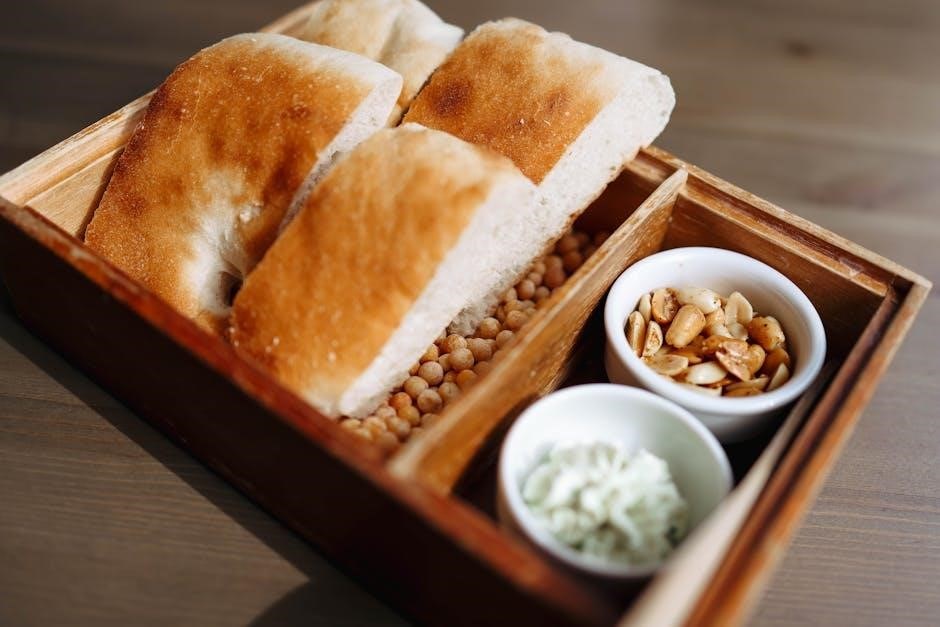
Features to Consider
Enhance your bread box with practical features like pull-out cutting boards, magnetic closures, and adjustable shelves. Add ventilation for freshness and ergonomic handles for easy access, ensuring functionality and style.
Incorporating a Pull-Out Cutting Board
Adding a pull-out cutting board to your bread box enhances functionality and convenience. This feature provides a dedicated space for slicing bread or preparing snacks, keeping your countertop clutter-free. Many bread box plans PDF include optional designs for this feature, often using a sliding drawer mechanism. The cutting board can be crafted from durable materials like hardwood or 1/2″ plywood, ensuring longevity. A smooth-gliding track system is essential for easy access. Some plans also include a built-in knife block or storage compartment beneath the cutting board, maximizing utility. This addition not only streamlines your kitchen workflow but also adds a touch of modern practicality to your handmade bread box.
Adding Magnetic Closures
Magnetic closures are a convenient and elegant way to secure your bread box door, ensuring it stays closed while maintaining easy access. These closures are simple to install and provide a smooth, professional finish. Many bread box plans PDF include instructions for fitting magnetic hinges, which are typically placed on the door and the box frame. This feature eliminates the need for visible latches or handles, creating a sleek appearance. Magnetic closures are durable and long-lasting, making them a practical choice for DIY enthusiasts. They are also easy to adjust, allowing for a perfect seal that keeps your bread fresh. This small detail can greatly enhance the functionality and aesthetic of your handmade bread box.
Including Adjustable Shelves
Add functionality to your bread box with adjustable shelves, perfect for customizing storage to suit your needs; These shelves allow you to organize bread, pastries, or snacks efficiently, ensuring optimal use of space. Many bread box plans PDF include designs for adjustable shelving, offering flexibility for varying loaf sizes or additional storage requirements. This feature is especially useful for larger families or those who bake frequently. The shelves can be easily installed using basic woodworking techniques, such as slot-and-groove systems or adjustable brackets. Incorporating adjustable shelves enhances the practicality of your bread box, making it a versatile and essential kitchen accessory. This detail is a great way to personalize your project and maximize its utility.
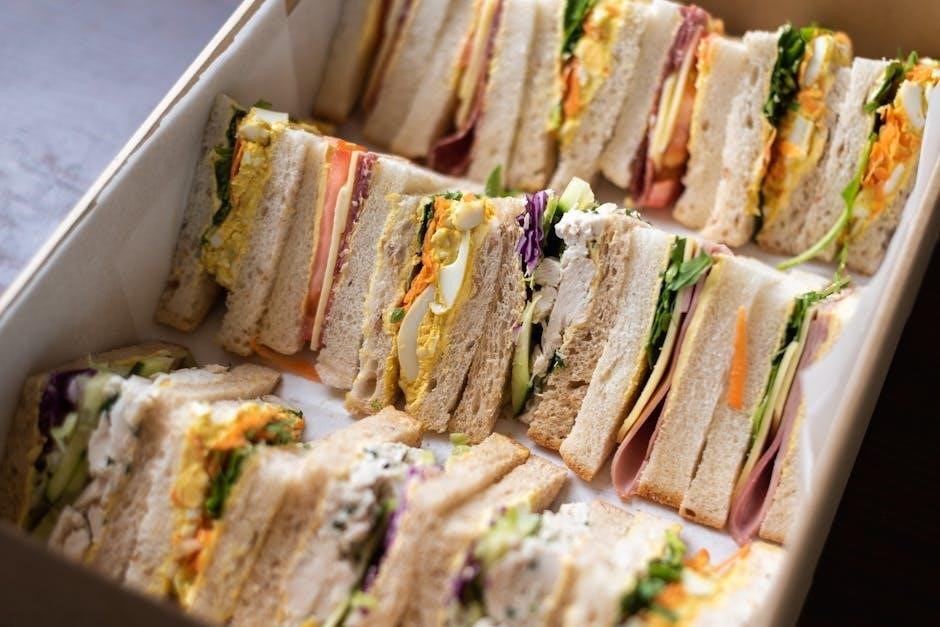
Finishing Touches
Complete your bread box with a professional finish by sanding and painting or applying a protective sealant. Add a personal touch with engraving or decals for a unique, polished look.
Sanding and Painting Techniques
For a smooth finish, start by sanding your bread box using progressively finer grit sandpaper, from 120 to 220 grit. This ensures all surfaces are even and splinter-free. After sanding, dust the box thoroughly with a tack cloth. Apply a high-quality primer if desired, followed by your chosen paint or stain. Use oil-based paints for durability or water-based for a natural look. Allow each coat to dry completely before applying the next. For added protection, finish with a clear sealant. Lightly sand between coats for optimal adhesion. To enhance the design, consider distressing edges or adding a stain for a rustic feel. Always work in a well-ventilated area and follow safety guidelines for painting.
Applying a Protective Finish
Applying a protective finish is essential to safeguard your bread box from moisture and wear. Use a water-resistant polyurethane or a food-safe wax to seal the wood. Start by ensuring the surface is clean and dry. Apply the finish evenly with a brush or cloth, following the manufacturer’s instructions. Allow the first coat to dry completely before lightly sanding and applying a second coat. For added durability, consider a third coat. Choose a finish that complements your kitchen’s style, such as a matte, satin, or glossy look. Always follow safety precautions and apply finishes in a well-ventilated area. A proper finish ensures your bread box remains functional and attractive for years to come.
Personalizing with Engraving or Decals
Add a personal touch to your bread box with engraving or decals. Use a wood burner to create custom designs, names, or patterns, making your project truly unique. For a more subtle look, apply vinyl decals with motivational quotes or kitchen-themed artwork. Ensure the surface is sanded smooth and dry before adding any designs. Once complete, seal the finish with a protective coat to preserve your artwork. This step allows you to express your creativity and make the bread box a one-of-a-kind piece that reflects your personality or matches your kitchen decor. Personalization transforms a functional item into a meaningful and eye-catching addition to your home.
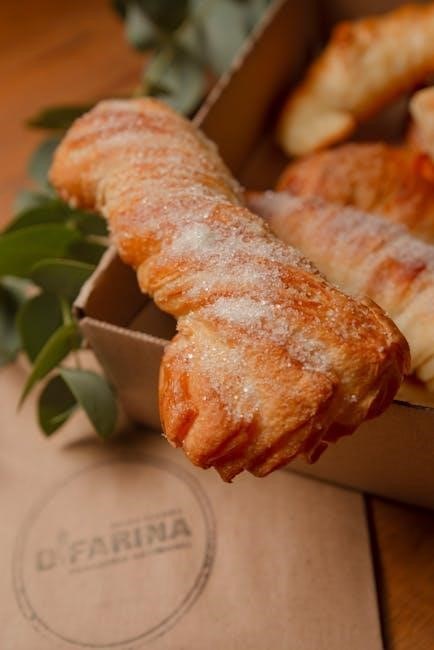
Free Bread Box Plans Available Online
Explore free bread box plans PDF online, offering downloadable templates and step-by-step guides. These plans are perfect for DIY enthusiasts, suitable for every skill level, and customizable to match your kitchen decor.
Popular Websites for Downloadable Plans
Several websites offer free bread box plans PDF for download, catering to various skill levels and design preferences. TEDS Woodworking provides an extensive collection of downloadable templates and blueprints. MyOutdoorPlans features simple yet detailed bread box designs with step-by-step instructions. Ana White offers free plans with photos and measurements, while Totally-Free-Woodworking-Plans.com includes a 6-page PDF with over 20 diagrams. Woodworkers Journal offers classic designs, and Instructables has a comprehensive guide with visuals. These platforms ensure you can find the perfect plan to suit your needs and enhance your woodworking skills.
How to Choose the Right Plan for Your Skill Level
Selecting the ideal bread box plan involves assessing your woodworking proficiency. Beginners should opt for plans labeled as “simple” or “starter-friendly,” often featuring basic designs with minimal tools. Look for plans with detailed instructions, clear diagrams, and a list of required materials. Avoid projects requiring advanced techniques or specialized tools. Intermediate woodworkers can explore designs with customizable features, while experienced craftsmen might enjoy complex designs with unique finishes. Reading reviews and checking the difficulty rating can guide your decision. Ensure the plan aligns with your skill level to enjoy a rewarding building experience and a functional bread box.
Modifying Plans to Fit Your Needs
Personalizing your bread box enhances functionality and style. Start by adjusting dimensions to fit your space or accommodate specific items; Consider adding features like pull-out shelves, magnetic closures, or ventilation for improved usability. Customizing the design allows you to incorporate personal preferences, such as engravings or unique finishes. Use available materials or repurpose items like reclaimed wood for an eco-friendly touch. Refer to online tutorials or woodworking guides for modification ideas. Ensure changes maintain structural integrity and purpose. Tailoring the plan to your needs ensures a practical and personalized storage solution that complements your kitchen decor perfectly.
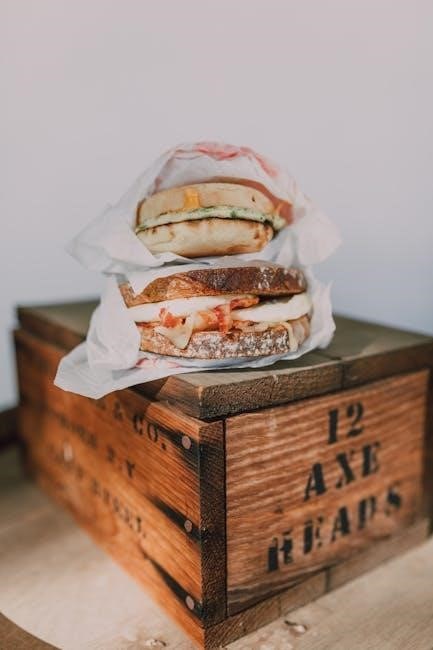
DIY Bread Box Ideas
Unleash your creativity with unique DIY bread box ideas. From upcycled pallet wood designs to two-story bread boxes, these projects offer functionality and style for your kitchen, with free PDF plans available online to guide your build.
Upcycled Pallet Wood Bread Boxes
Transform reclaimed pallet wood into a charming and eco-friendly bread box. This budget-friendly option offers a rustic, vintage appeal while reducing waste. Easy to customize, pallet wood bread boxes can be designed with a Plexiglass window for visibility or a pull-out cutting board for added functionality. Sanding and sealing the wood ensures durability and a polished finish. Perfect for DIY enthusiasts, these plans are widely available online, providing step-by-step guides to create a unique and practical kitchen storage solution that combines sustainability with style.
Building a Two-Story Bread Box
A two-story bread box offers ample storage while saving kitchen space. Designed with two compartments, it allows you to separate different types of bread or pastries. Plans often include materials like plywood or MDF, with customizable features such as tambour doors or pull-out shelves. Magnetic closures ensure airtight storage, keeping bread fresh. Step-by-step guides provide measurements and assembly tips. Perfect for DIY enthusiasts, this project combines functionality with a modern aesthetic, making it a practical addition to any kitchen. Ensure proper ventilation and secure closures for optimal performance. With detailed blueprints available, building a two-story bread box is a rewarding and achievable woodworking project.
Adding a Plexiglass Window for Visibility
Enhance your bread box with a plexiglass window for easy visibility of stored bread. This feature allows you to check contents without opening the box, maintaining freshness. The plexiglass is durable and easy to install, fitting seamlessly into the design. Many free bread box plans PDF include measurements for cutting and securing the plexiglass. A rubber seal ensures airtight closure, while the transparent material adds a modern touch. Cleaning is simple, and the window withstands kitchen humidity. This upgrade improves functionality and aesthetics, making it a popular choice for DIY enthusiasts. Detailed instructions in the plans guide you through the process, ensuring a professional finish. Perfect for visibility and convenience, a plexiglass window elevates your bread box design.
Creating a bread box is a rewarding DIY project with numerous free plans available online, helping you craft a functional and stylish kitchen essential.
Final Tips for Successful Bread Box Building
Ensure precise measurements and use templates for cutting shaped ends and tambour slots. Sand thoroughly before finishing to achieve a smooth surface. Apply a protective finish like oil or wax for durability; For door alignment, attach hinges carefully and leave a small gap at the bottom. Add ventilation holes to maintain airflow and prevent moisture buildup. Install handles or magnetic closures securely for easy access. Consider customizing with paint or engravings to match your kitchen style. Finally, consult free bread box plans PDF for detailed guidance and modify designs to suit your needs. With patience and attention to detail, your bread box will be both functional and elegant.
Sharing Your Project and Getting Feedback
Sharing your bread box project online or with woodworking communities can provide valuable insights and suggestions. Post photos and descriptions of your build on forums or social media to connect with fellow DIY enthusiasts. Be open to constructive feedback, as it can help refine your skills and inspire future projects. Many creators share their experiences and tips, fostering a supportive environment for learners. Documenting your process and final results also helps others understand your approach. By engaging with the community, you contribute to the growth of DIY woodworking and may discover new ideas or modifications for your bread box designs. Sharing your success story can motivate others to start their own projects, creating a cycle of creativity and improvement.





